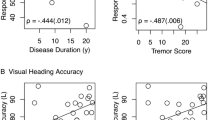Abstract
Visuoperceptual disorders have been identified in individuals with Parkinson’s disease (PD) and may affect the perception of optic flow for heading direction during navigation. Studies in healthy subjects have confirmed that heading direction can be determined by equalizing the optic flow speed (OS) between visual fields. The present study investigated the effects of PD on the use of optic flow for heading direction, walking parameters, and interlimb coordination during navigation, examining the contributions of OS and spatial frequency (dot density). Twelve individuals with PD without dementia, 18 age-matched normal control adults (NC), and 23 young control adults (YC) walked through a virtual hallway at about 0.8 m/s. The hallway was created by random dots on side walls. Three levels of OS (0.8, 1.2, and 1.8 m/s) and dot density (1, 2, and 3 dots/m2) were presented on one wall while on the other wall, OS and dot density were fixed at 0.8 m/s and 3 dots/m2, respectively. Three-dimensional kinematic data were collected, and lateral drift, walking speed, stride frequency and length, and frequency, and phase relations between arms and legs were calculated. A significant linear effect was observed on lateral drift to the wall with lower OS for YC and NC, but not for PD. Compared to YC and NC, PD veered more to the left under OS and dot density conditions. The results suggest that healthy adults perceive optic flow for heading direction. Heading direction in PD may be more affected by the asymmetry of dopamine levels between the hemispheres and by motor lateralization as indexed by handedness.



Similar content being viewed by others
References
Armstrong CA, Oldham JA (1999) A comparison of dominant and non-dominant hand strengths. J Hand Surg Br 24:421–425
Azulay JP, Mesure S, Amblard B, Blin O, Sangla I, Pouget J (1999) Visual control of locomotion in Parkinson’s disease. Brain 122(Pt 1):111–120
Barbeau A (1986) Parkinson’s disease: clinical features and etio-pathology. In: Vinken P, Bruyn G, Klawans H (eds) Handbook of clinical neurology, vol 49. Elsevier, Amsterdam, pp 87–152
Batschelet E (1981) Circular statistics in biology. Academic Press, London
Bodis-Wollner I, Yahr MD (1978) Measurements of visual evoked potentials in Parkinson’s disease. Brain 101:661–671
Bodis-Wollner I, Yahr MD, Mylin L, Thornton J (1982) Dopaminergic deficiency and delayed visual evoked potentials in humans. Ann Neurol 11:478–483
Bracha HS, Shults C, Glick SD, Kleinman JE (1987) Spontaneous asymmetric circling behavior in hemi-parkinsonism; a human equivalent of the lesioned-circling rodent behavior. Life Sci 40:1127–1130
Chatziastros A, Wallis GM, Bülthoff HH (1999) The use of splay angle and optical flow in steering a central path (Technical Report 72). Max Planck Institute for Biological Cybernetics, Tubingen
Chen Y, Bedell HE, Frishman LJ (1998) The precision of velocity discrimination across spatial frequency. Percept Psychophys 60:1329–1336
Chou YH, Wagenaar RC, Saltzman E, Giphart JE, Young D, Davidsdottir R, Cronin-Golomb A (2009) Effects of optic flow speed and lateral flow asymmetry on locomotion in younger and older adults: a virtual reality study. J Gerontol B Psychol Sci Soc Sci 64:222–231
Cromwell RL, Newton RA, Forrest G (2002) Influence of vision on head stabilization strategies in older adults during walking. J Gerontol A Biol Sci Med Sci 57:M442–M448
Davidsdottir S, Cronin-Golomb A, Lee A (2005) Visual and spatial symptoms in Parkinson’s disease. Vision Res 45:1285–1296
Davidsdottir S, Wagenaar R, Young D, Cronin-Golomb A (2008) Impact of optic flow perception and egocentric coordinates on veering in Parkinson’s disease. Brain 131:2882–2893
de la Fuente-Fernandez R, Kishore A, Calne DB, Ruth TJ, Stoessl AJ (2000) Nigrostriatal dopamine system and motor lateralization. Behav Brain Res 112:63–68
Diener HC, Wist ER, Dichgans J, Brandt T (1976) The spatial frequency effect on perceived velocity. Vision Res 16:169–176
Djaldetti R, Ziv I, Melamed E (2006) The mystery of motor asymmetry in Parkinson’s disease. Lancet Neurol 5:796–802
Donker SF, Beek PJ, Wagenaar RC, Mulder T (2001) Coordination between arm and leg movements during locomotion. J Mot Behav 33:86–102
Duchon AP, Warren WH (2002) A visual equalization strategy for locomotor control: of honeybees, robots, and humans. Psychol Sci 13:272–278
Ehgoetz Martens KA, Pieruccini-Faria F, Almeida QJ (2013a) Could sensory mechanisms be a core factor that underlies freezing of gait in Parkinson’s disease. PLoS ONE 8:e62602. doi:10.1371/journal.pone.0062602
Ehgoetz Martens KA, Pieruccini-Faria F, Silveira CRA, Almeida QJ (2013b) The contribution of optic flow to freezing of gait in left- and right-PD: different mechanisms for a common phenomenon? Parkinsonism Relat Disord 19:1046–1048
Folstein MF, Folstein SE, McHugh PR (1975) “Mini-mental state”. A practical method for grading the cognitive state of patients for the clinician. J Psychiatr Res 12:189–198
Giphart JE, Chou YH, Kim DH, Bortnyk CT, Wagenaar RC (2007) Effects of virtual reality immersion and walking speed on coordination of arm and leg movements. Presence 16:399–413
Hallemans A, Ortibus E, Meire F, Aerts P (2010) Low vision affects dynamic stability of gait. Gait Posture 32:547–551
Harris JP, Atkinson EA, Lee AC, Nithi K, Fowler MS (2003) Hemispace differences in the visual perception of size in left hemi-Parkinson’s disease. Neuropsychologia 41:795–807
Hoehn MM, Yahr MD (2001) Parkinsonism: onset, progression, and mortality. 1967. Neurology 57:S11–S26
Laudate TM, Neargarder S, Cronin-Golomb A (2013) Line bisection in Parkinson’s disease: investigation of contribution of visual field, retinal vision, and scanning patterns to visuospatial function. Behav Neurosci 127:151–163
Lee A, Harris J (1999) Problems with perception of space in Parkinson’s disease: a questionnaire study. Neuro-Ophthalmology 22:1–15
Lee AC, Harris JP, Atkinson EA, Fowler MS (2001a) Evidence from a line bisection task for visuospatial neglect in left hemiparkinson’s disease. Vision Res 41:2677–2686
Lee AC, Harris JP, Atkinson EA, Fowler MS (2001b) Disruption of estimation of body-scaled aperture width in Hemiparkinson’s disease. Neuropsychologia 39:1097–1104
Lewek MD, Poole R, Johnson J, Halawa O, Huang X (2010) Arm swing magnitude and asymmetry during gait in the early stages of Parkinson’s disease. Gait Posture 31:256–260
Lewis GN, Byblow WD, Walt SE (2000) Stride length regulation in Parkinson’s disease: the use of extrinsic, visual cues. Brain 123:2077–2090
Martin WE, Loewenson RB, Resch JA, Baker AB (1973) Parkinson’s disease. Clinical analysis of 100 patients. Neurology 23:783–790
Mattis S (1976) Mental status examination for organic mental syndromes in the elderly patient. In: Bellak LK, Toksoz BE (eds) Geriatric psychiatry. Grune & Stratton, New York, pp 77–121
Mattis S (1988) Dementia rating scale: professional manual. Psychological Assessment Resources Inc., Odessa, FL
McKee SP, Silverman GH, Nakayama K (1986) Precise velocity discrimination despite random variations in temporal frequency and contrast. Vision Res 26:609–619
Mestre D, Blin O, Serratrice G (1992) Contrast sensitivity is increased in a case of nonparkinsonian freezing gait. Neurology 42:189–194
Mohr C, Landis T, Bracha HS, Brugger P (2003) Opposite turning behavior in right-handers and non-right-handers suggests a link between handedness and cerebral dopamine asymmetries. Behav Neurosci 117:1448–1452
Morris ME, Iansek R, Matyas TA, Summers JJ (1994) The pathogenesis of gait hypokinesia in Parkinson’s disease. Brain 117(Pt 5):1169–1181
Morris ME, Iansek R, Matyas TA, Summers JJ (1996) Stride length regulation in Parkinson’s disease. Normalization strategies and underlying mechanisms. Brain 119:551–568
Oldfield RC (1971) The assessment and analysis of handedness: the Edinburgh inventory. Neuropsychologia 9:97–113
Plotnik M, Giladi N, Balash Y, Peretz C, Hausdorff JM (2005) Is freezing of gait in Parkinson’s disease related to asymmetric motor function? Ann Neurol 57:656–663
Prokop T, Schubert M, Berger W (1997) Visual influence on human locomotion. Modulation to changes in optic flow. Exp Brain Res 114:63–70
Sadeghi H, Allard P, Prince F, Labelle H (2000) Symmetry and limb dominance in able-bodied gait: a review. Gait Posture 12:34–45
Sadeghi H, Sadeghi S, Allard P, Labelle H, Duhaime M (2001) Lower limb muscle power relationships in bilateral able-bodied gait. Am J Phys Med Rehabil 80:821–830
Schubert M, Prokop T, Brocke F, Berger W (2005) Visual kinesthesia and locomotion in Parkinson’s disease. Mov Disord 20:141–150
Srinivasan MV, Lehrer M, Kirchner WH, Zhang SW (1991) Range perception through apparent image speed in freely flying honeybees. Vis Neurosci 6:519–535
Thiebaut de Schotten M, Dell’Acqua F, Forkel SJ, Simmons A, Vergani F, Murphy DG, Catani M (2011) A lateralized brain network for visuospatial attention. Nat Neurosci 14:1245–1246
van Emmerik RE, Wagenaar RC (1996) Effects of walking velocity on relative phase dynamics in the trunk in human walking. J Biomech 29:1175–1184
Wagenaar RC, van Emmerik RE (2000) Resonant frequencies of arms and legs identify different walking patterns. J Biomech 33:853–861
Warren WH Jr, Kay BA, Zosh WD, Duchon AP, Sahuc S (2001) Optic flow is used to control human walking. Nat Neurosci 4:213–216
Watamaniuk SN, Grzywacz NM, Yuille AL (1993) Dependence of speed and direction perception on cinematogram dot density. Vision Res 33:849–859
Yogev G, Plotnik M, Peretz C, Giladi N, Hausdorff JM (2007) Gait asymmetry in patients with Parkinson’s disease and elderly fallers: when does the bilateral coordination of gait require attention? Exp Brain Res 177:336–346
Young DE, Wagenaar RC, Lin CC, Chou YH, Davidsdottir S, Saltzman E, Cronin-Golomb A (2010) Visuospatial perception and navigation in Parkinson’s disease. Vision Res 50:2495–2504
Acknowledgments
This work was supported by the National Institute of Neurological Disorders and Stroke 1R01NS067128 to ACG. The study was presented in part at the ACRM-ASNR Annual Conference, 2011. Our recruitment efforts were supported, with our gratitude, by Marie Saint-Hilaire, MD and Cathi Thomas, RN, MSN, of Boston Medical Center Neurology Associates, and by Boston area Parkinson disease support groups. We thank Chelsea Toner and Laura Pistorino, who assisted in participant recruitment and data management, and Boston University’s Scientific Computing and Visualization staff members Erik Brisson and Robert Putnam, who provided expert technical support. We are deeply grateful to all of the individuals who participated in this study. We dedicate this paper to the memory of our colleague and friend, Robert Wagenaar.
Author information
Authors and Affiliations
Corresponding author
Rights and permissions
About this article
Cite this article
Lin, CC., Wagenaar, R.C., Young, D. et al. Effects of Parkinson’s disease on optic flow perception for heading direction during navigation. Exp Brain Res 232, 1343–1355 (2014). https://doi.org/10.1007/s00221-014-3853-9
Received:
Accepted:
Published:
Issue Date:
DOI: https://doi.org/10.1007/s00221-014-3853-9




